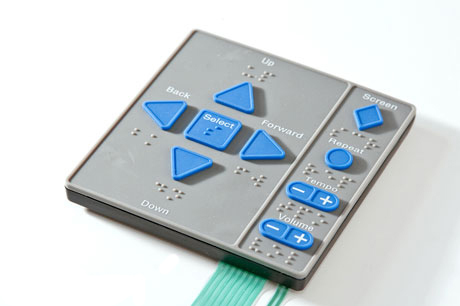How Membrane Switch Technology is Revolutionizing User Interfaces
How Membrane Switch Technology is Revolutionizing User Interfaces
Blog Article
Understanding Membrane Layer Switches Over: The Trick to Reputable and sturdy Controls

What Are Membrane Buttons?
Membrane layer switches are an innovative option in the realm of interface innovation, combining capability and design seamlessly. These devices act as an interface between customers and electronic systems, incorporating a number of elements right into a compact layout. Normally built from versatile, slim layers of materials, membrane switches are made to reply to touch, making it possible for users to engage with equipment and digital gadgets successfully.
The key components of a membrane layer button include a printed circuit layer, visuals overlay, and a spacer layer that prevents unintentional activation. The visuals overlay can be personalized to mirror brand name identification or customer choices, boosting aesthetics while making certain use. Membrane layer buttons are generally made use of in various applications, including clinical gadgets, customer electronic devices, and commercial tools, owing to their longevity and resistance to environmental variables such as dampness and dirt.
Among the key advantages of membrane layer buttons is their ability to withstand deterioration, making them ideal for high-traffic environments. In addition, they are lightweight and require marginal room, permitting innovative layouts in product growth. Overall, membrane layer switches stand for a reliable and practical selection for modern-day electronic interfaces, weding modern technology with user-centric design principles.
Just How Membrane Changes Job
The procedure of membrane layer switches over joints on an easy yet effective mechanism that converts user input right into electronic signals. When an individual presses the button, the leading layer deforms, enabling a conductive aspect in the circuit layer to make call with a corresponding conductive pad on the underside of the graphic overlay.
The design of membrane layer buttons can differ, yet they often integrate domes or tactile aspects to give feedback to the user, enhancing the overall experience - membrane switch. The materials made use of in membrane buttons, such as polyester or polycarbonate, contribute to their resilience and resistance to ecological factors, consisting of dampness and dust. Additionally, the published circuits are generally enveloped, which secures them from deterioration gradually.
Benefits of Membrane Layer Buttons

Furthermore, membrane layer switches are recognized for their resilience. Built from robust products, they are immune to dirt, moisture, and physical wear, which dramatically expands their lifespan contrasted to typical mechanical switches. This resilience makes them particularly appropriate for high-traffic atmospheres and applications needing longevity.
An additional substantial benefit is the convenience of cleaning and upkeep. The smooth surface area of membrane switches reduces dust build-up and is often invulnerable to spills, making them excellent for settings that need constant sanitization.
In addition, membrane buttons offer a structured profile, bring about a thinner layout that can be incorporated right into numerous gadgets without including mass. This function not just enhances the visual appeal however also adds to a much more ergonomic product design.
Applications of Membrane Switches
Functional and user-friendly, membrane layer switches locate applications throughout a broad range of sectors, including medical tools, consumer electronics, and industrial devices. In the medical area, these switches are essential to gadgets such as analysis equipment, person monitoring systems, and infusion pumps, where dependability and convenience of cleaning are vital. Their ability to keep and stand up to rough settings performance makes them ideal for such applications.

In consumer electronic devices, membrane switches are made use of in products why not try these out like microwaves, cleaning machines, and remotes - membrane switch. Their sleek design enables user-friendly interface, improving the total individual experience while providing longevity and resistance to deterioration
Industrial tools additionally benefits from membrane layer switches, particularly in control panels for machinery and automation systems. These buttons use security versus dust and moisture, ensuring constant performance in difficult environments. Furthermore, their personalized features enable manufacturers to customize them to details functional requirements, enhancing efficiency and capability.
Selecting the Right Membrane Switch
When selecting a membrane layer button, it is important to consider different aspects that influence efficiency and viability for particular applications. The key considerations consist of ecological conditions, responsive feedback, durability, and design requirements.
First, examine the operating environment; switches exposed to moisture, chemicals, or severe temperatures call for details products to make sure durability and additional resources functionality. Next off, assess the requirement for responsive feedback. Relying on user communication, some applications may benefit from a responsive action to verify activation, while others may prefer a non-tactile design for visual factors.
Sturdiness is an additional important aspect; membrane layer buttons ought to be made to hold up against constant use, effects, and abrasion. Guarantee the selected button can withstand the anticipated lifecycle, specifically in high-usage scenarios.

Final Thought
Finally, membrane changes serve as necessary elements in the design of long lasting and dependable control systems throughout different markets. Their compact layout, combined with durable building and construction and customizable attributes, enhances user communication while making certain long life sought after settings. The convenience of membrane changes permits for customized services that fulfill certain operational needs, reinforcing their significance in modern innovation. As industries continue to progress, the importance of incorporating reliable membrane switch services can not be overstated.
Membrane layer switches over represent a crucial facet of modern-day interface layout, mixing performance with resilience in various applications.Membrane switches are a sophisticated service in the world content of customer interface modern technology, combining functionality and design seamlessly. Typically constructed from adaptable, thin layers of materials, membrane layer buttons are designed to respond to touch, making it possible for customers to engage with equipment and electronic devices effectively.
The style of membrane layer switches can vary, yet they frequently integrate domes or tactile aspects to offer comments to the customer, improving the overall experience.In final thought, membrane layer switches over offer as necessary parts in the layout of trusted and resilient control systems throughout different sectors.
Report this page